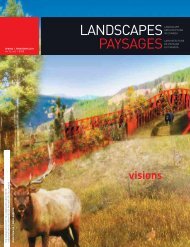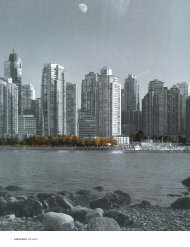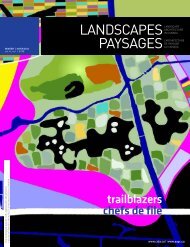time + place temps + lieu - CSLA :: AAPC
time + place temps + lieu - CSLA :: AAPC
time + place temps + lieu - CSLA :: AAPC
Create successful ePaper yourself
Turn your PDF publications into a flip-book with our unique Google optimized e-Paper software.
4<br />
In 2005, Calgary had identified<br />
just two cultural landscapes.<br />
Today, there are almost 70.<br />
En 2005, Calgary ne<br />
répertoriait que deux paysages<br />
aménagés. Aujourd’hui, on<br />
en compte près de 70.<br />
EVERYDAY CONNECTIONS<br />
Much of the value of local cultural landscapes lies in the everyday<br />
connections. A walk on the way to work through the formal<br />
Edwardian garden of Central Memorial Park is markedly different<br />
from our experience visiting a distant National Historic Site, no<br />
matter how awe-inspiring. Local sites are with us daily; they<br />
form the history and heritage in the ground beneath our feet.<br />
On Remembrance Day in Calgary, for example, as people gather<br />
in Central Memorial Park to remember, Mr. Gordon Rowan is also<br />
present. He is a Navy Veteran who has polished the brass on the<br />
Cenotaph in the park twice a year for as long as he can remember.<br />
We learn the stories and feel the connections when we witness<br />
the yearly harvest at the Bridgeland-Riverside Vacant Lots<br />
Garden. Many Calgarians have met local legend Marsh Libicz,<br />
who has gardened there since the 1930s. The garden’s existence<br />
today is something of a miracle. It was originally just one of 3229<br />
gardens created by The Vacant Lots Garden Club during the early<br />
establishment of Calgary and into the war years. Other gardens<br />
disappeared under development during the 1950s, but this one was<br />
spared because of its awkward location for developers. The garden<br />
lived on, actively tended by community members for over 80 years<br />
before rising land values in 2007 put it at risk. That risk, ironically,<br />
provoked formal designation of the site and its transfer into the<br />
Parks inventory as a Municipal Historic Resource.<br />
FORGOTTEN PLACES, NEWLY DISCOVERED<br />
The history of many landscapes can be forgotten over <strong>time</strong>, but<br />
with a little research, the significance of <strong>place</strong>s in most Canadian<br />
cities can easily be rediscovered. For researchers, much of the joy<br />
lies in uncovering the forgotten history. Only in 2010 did researchers<br />
rediscover that the Calgary communities of South Mount Royal and<br />
Sunalta were subdivisions designed by John Charles Olmsted of the<br />
Olmsted Brothers firm. Today the parks in those communities, with<br />
the picturesque form that responds to the natural topography of the<br />
land, are conserved as cultural landscapes.<br />
HOW WE BEGIN<br />
Every city considering its cultural landscapes will begin with wellloved<br />
historic gardens and parks. In Calgary, Central Memorial Park<br />
and Reader Rock Garden, both Edwardian era gems, were obvious.<br />
Both have a clearly designed, man-made form (UNESCO would define<br />
it as “landscapes designed and created intentionally by man.”)<br />
Central Memorial Park is a Victorian-inspired geometric carpet bed<br />
design. Reader Rock Garden is an Arts and Crafts style rockery. In<br />
both <strong>place</strong>s, the initial impression is historic site because the purity<br />
of the form is not something landscape architects would design<br />
today. It’s not a surprise that these were the first two cultural<br />
landscapes identified by the Calgary Heritage Authority. But how do<br />
you start to identify sites that aren’t as obvious?<br />
In Calgary, we began with a windshield study – visiting <strong>place</strong>s<br />
and opining if any of them appeared to have any potential heritage<br />
value. Riley Park and the Senator Patrick Burns Rock Garden were<br />
identified early on due to their unique designs. But beyond the<br />
aesthetic <strong>place</strong>s are <strong>place</strong>s people just know are old and significant;<br />
Calgary has Bowness Park and Memorial Drive. These <strong>place</strong>s may<br />
have changed over <strong>time</strong> but they’ve always been here, they have<br />
always been a part of Calgarians’ lives. (UNESCO would classify<br />
these as “organically evolved landscapes - continuing.”)<br />
Many of these <strong>place</strong>s are beloved by citizens who bring their<br />
own history to the <strong>place</strong>. One such Calgarian is Georgie Leach, who<br />
can tell a wonderful story about meeting her husband at a picnic<br />
in Bowness Park. Today, more than 50 years later, she brings her<br />
grandchildren to the park. These experiences can’t be replicated in<br />
newly formed spaces. And if the space is managed well, even first<br />
<strong>time</strong> visitors to an historic <strong>place</strong> like Bowness Park can sense the<br />
history that is there to discover.<br />
GREAT EVENTS AND CITY DEVELOPMENT<br />
Historic events are also clues prompting discovery. In Calgary,<br />
Central Memorial Park, Memorial Drive, Battalion Park and<br />
Burnsland Cemetery are all linked to the Great War. The centennial<br />
of Canada’s Confederation was marked with Confederation Park,<br />
Calgary’s centennial with the creation of Century Gardens, the 1988<br />
Olympics with Calgary’s Olympic Plaza. UNESCO would classify<br />
these landscapes as “associative cultural landscapes.”<br />
Less obvious are those <strong>place</strong>s whose discovery depends<br />
on understanding the development of the city. Historians<br />
and conservationists develop <strong>time</strong>lines outlining periods of<br />
development, cataloguing different social and design influences and<br />
identifying people that impacted the city’s built form.<br />
Calgary’s list includes archaeological sites and areas used by the<br />
First Nations. These <strong>place</strong>s, classified by UNESCO as “organically<br />
40 LANDSCAPES PAYSAGES






